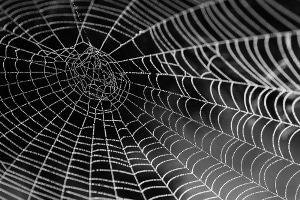Mar 14 2017
Do spiders use their web as a computer? New research, led by the Universities of Bristol and Oxford, will look at spiders’ webs to investigate their computational capabilities and based on this research they will develop new sensor technology to measure vibrations and flow.
 Credit: Bristol University
Credit: Bristol University
Spiders’ webs have evolved over hundreds of millions of years and can be surprisingly complex. Their obvious functionality is to catch and hold prey. However, their remarkably complex structure suggests they can do even more. The web could potentially serve as a signal-processing device. It could therefore help the spider to locate and categorize robustly its prey and other events like broken threads or mates. The spider might use its web as a computer.
It is known that spiders have sensitive mechanoreceptors on their legs that allow them to measure vibrations. Spiders also probe their webs by sending out vibrations and observing how it responds in form of vibration patterns. This suggests that the web is not only a static, passive structure to catch prey, but can rather actively contribute to the pattern recognition task to locate and categorize everything that is happening in the web.
This interdisciplinary research project, which is funded by a Leverhulme Trust Research Project Grant of over £250,000, will look at the sophisticated structure of spiders’ webs to understand how these morphologies can carry out computation. This is usually referred to as Morphological Computation. This is a design approach, often used in robotics, which considers the body of a robot crucial for any intelligent behaviour. Like in the case of morphological computation based robot designs, spiders seem to defer computational tasks to a morphological structure, such as, the spider outsources pattern recognition to the web.
Dr Helmut Hauser, Lecturer in Robotics in the Department of Engineering Mathematics at the University of Bristol, who is leading the project, said: "The idea of intelligent morphological structures is not just useful for spiders, but can be developed into novel, intelligent sensor technologies, especially for vibration and flow sensors.
"We also believe on-demand deployable morphology-based computational devices is of great interest for robotics. Potential uses for the technology include maintenance robots that swarm through tubes building flow sensors at key points to identify irregularities, or climbing robots that construct vibration sensors at strategic places on buildings to detect earthquakes or structural failure.
"The project will provide a fundamentally new way of building sensors by employing a design approach that carefully considers morphological features. The aim is to obtain highly robust and intelligent sensors capable of carrying out relevant signal processing through their structures."
Professor Fritz Vollrath from the Department of Zoology at the University of Oxford, added: "It will be interesting to see how far spiders are able to develop their catching-nets into gossamer-sensors, and how accurate a particular web can inform its spider about prey caught and about predators on the prowl."
The research team believe the results of this study could provide significant insights on the way we think about the morphological features of biological sensors in general and has the potential to open new pathways for bio-inspired sensor design.
The interdisciplinary project will combine biological experimentation, simulation and mathematical modelling to understand the underlying principles. Based on these insights the researchers will develop a completely new sensor technology that can be used for vibration and flow measurements. In addition, the project will design robotic prototypes that will be capable to deploy this sensor on the demand.